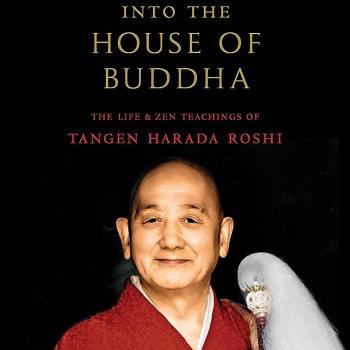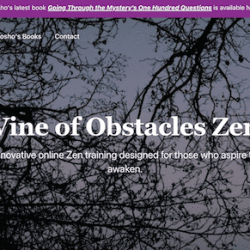I’ve been rereading the introduction of Zen Sand: The Book of Capping Phrases for Koan Practice by Victor Sogen Hori, a long-time practitioner of Rinzai Zen in Japan, and reflecting on the “capping phrase” process that we’re using for the present 100-day training (finding a phrase to express our practice-as-it-really-is each week).
Meanwhile, the study focus now is from the source of the Soto stream, Dogen-zenji, and these lines from Genjokoan:
“To convey the self toward the 10,000 dharmas to do practice/verification is illusion.
The 10,000 dharmas advancing and practicing/verifying through the self is satori.”
While reading Rinzia-guy Hori, I just had one of those “coming together” moments of traditions entwining that I’d like to share with you.
Although there are differences between Soto and Rinzai Zen, I’ve always been more interested in their similarities. It seems to me that some of major differences, especially about the most important things, are semantic. Take, for example, the matter of “kensho,” literally “seeing [true] nature.”
Below, I’ll first offer you a passage (marked “Exhibit A”) from Zen Sand (p. 7) and then a selection from the Genjokoan by old Soto man Dogen (“Exhibit B”). The following passage from Hori, by the way, also makes an important distinction between samadhi and insight that I encourage you practitioners to pay careful attention too.
Exhibit A:
Kensho, the experience of awakening, is more than merely the state of concentrated samadhi. When the Great Doubt has totally taken over the self, there is no more distinction between self and other, subject and object. There is no more differentiation, no more attachment. This is merely samadhi and not kensho. Kensho is not the self’s withdrawal from the conventional world, but rather the selfless self breaking back into the conventional world. It is only when this samadhi has been shattered that a new self arises. This self returns and again sees the things of the world as objects, but now as empty objects; it again thinks in differentiated categories and feels attachment, but now with insight into their emptiness.
Exhibit B:
To study buddha way is to study the self. To study the self is to forget the self. To forget the self is to be verified by all things. To be veri¬fied by all things is to let the body and mind of the self, and body and mind of others, drop off. There is a trace of realization that cannot be grasped. We endlessly keep expressing the un¬graspable trace of realization.
Dogen didn’t often used the word kensho and when he did he tended to belittle it and likened it to “…playing in the entranceway, still short of the vital path of emancipation.”
Nevertheless, what Dogen describes above – studying, forgetting, verifying, dropping self and other, ungraspable realization, endless expression – certainly has strong resonance with Hori’s words above – no distinction between self and other, selfless self breaking back into the conventional world ( “…the 10,000 dharmas advancing and practicing/verifying through the self is satori”), thinking again but with insight into emptiness (e.g., nonthinking).
The rusty barrel has been in the woods a long time – but it leaked from the start.
The most important point, whether you identify with the Rinzai line and use the word kensho or with the Soto line and use “verification,” is to practice in such a way that you might nod and smile to yourself, no longer a believer or a by-stander.











